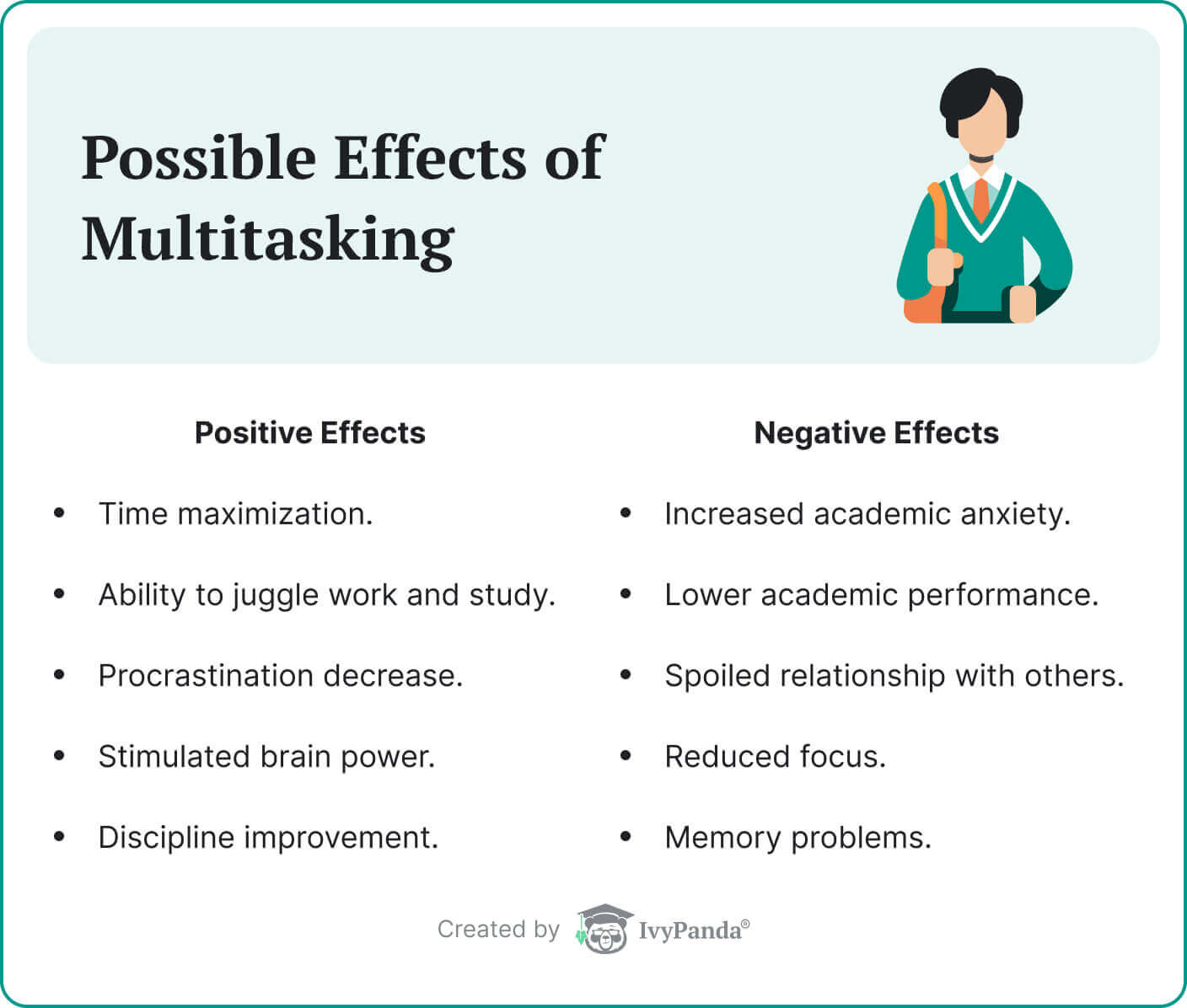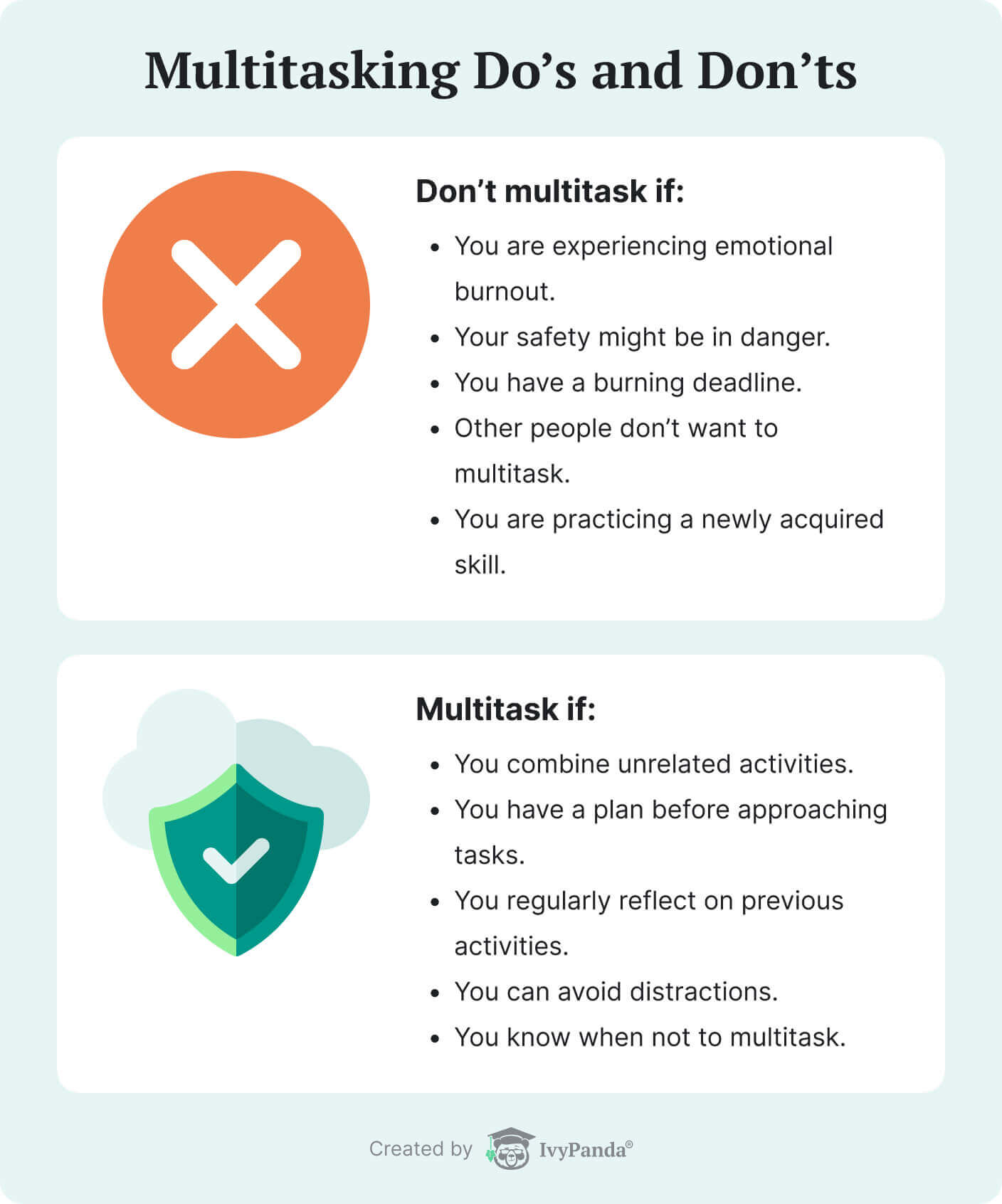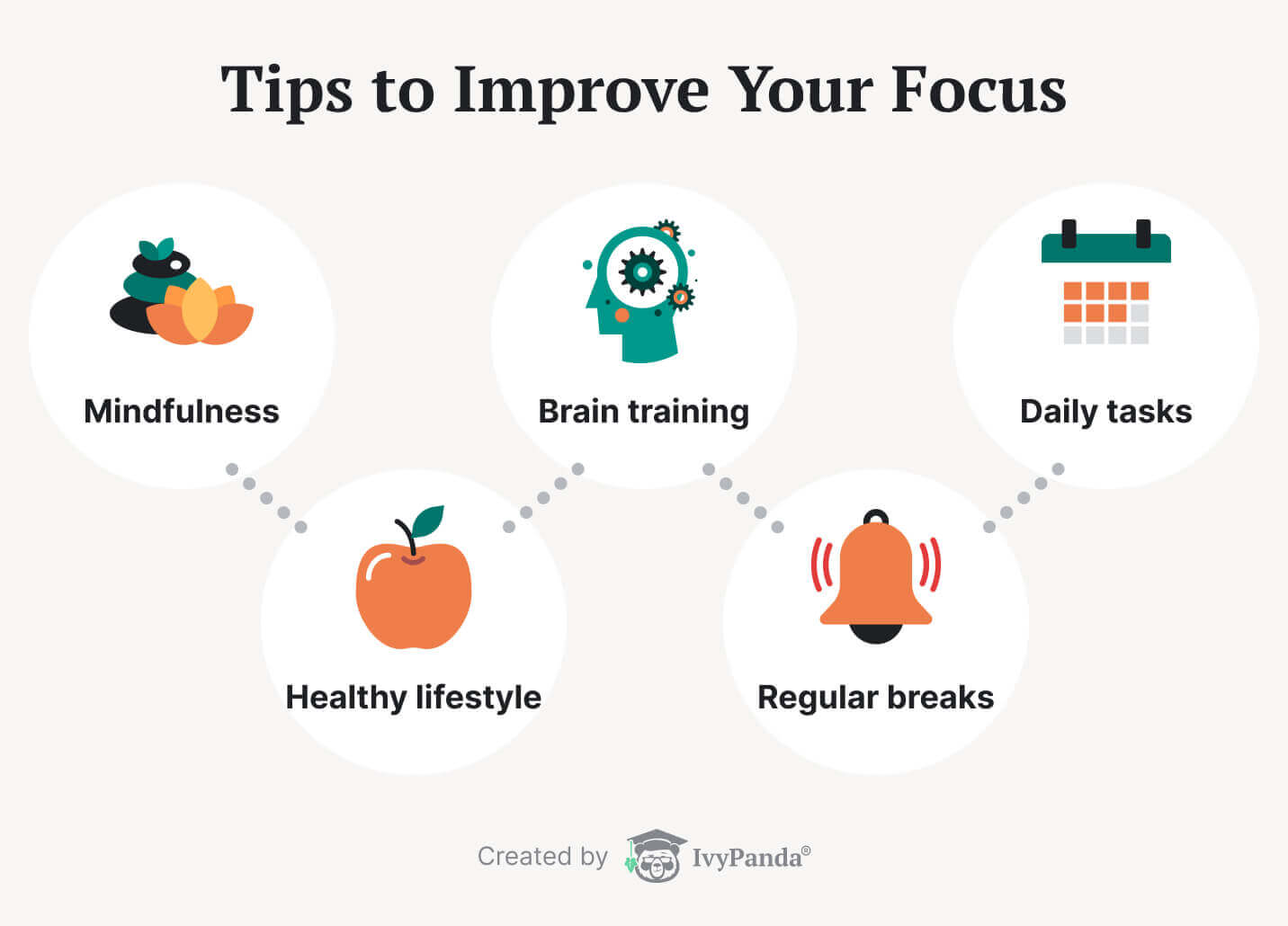What was your dream superpower as a child? Invisibility? Ability to fly? Maybe telekinesis? Many magical skills remain exciting even for grown-ups, but the most desirable superpower when you get older is the skill to do several things simultaneously.
With the modern pace of living, it is expected that many people dream about it. However, while some see multitasking as a superpower, others believe it makes us less productive.

In this article, we’ll look deeper at one of the most debatable 21st-century skills and find out how to reap all the benefits it has. Don’t miss IvyPanda’s free database of essays, where you can find lots of helpful materials on sciences, business, art, law, and many other topics.
🤹 What Is Multitasking?
Multitasking is when you handle several tasks at once, either by switching between them or actually doing two or more activities simultaneously. This skill can be useful in certain situations, but it often reduces efficiency, especially when tasks demand full focus to prevent errors. Research suggests that with practice and the right strategies, people can enhance their ability to multitask effectively.
Initially, multitasking was adopted from computer technologies. In an operating system, a user can run more than one application at the same time, thanks to the computer’s ability to multitask.
Here are other examples from different aspects of life:
- Taking notes while listening to a lecture.
- Driving a car while talking with passengers.
- Monitoring social media while watching a movie.
- Taking several restaurant orders at once.
- Reading a book while eating lunch.
- Cooking multiple dishes at once.
What Multitasking Is Not:
Most disputes on multitasking arise when it is confused with task-switching. In this case, you shift your attention from one thing to another, while multitasking implies specifically doing things simultaneously.
Multitasking ≠ Task-Switching
Imagine constantly checking your social media accounts while writing an essay. This is task switching – you don’t do the two activities at the same moment. Instead, you bounce back and forth between writing and scrolling through social media, just like a ping-pong ball. Your Instagram feed gets your attention for a few minutes, and then you focus on your essay. When you switch tasks like this, you aren’t fully engaged in any of them.

Multitasking Misconceptions
Various myths blur the correct perception of multitasking. Let’s debunk the most common ones:
- 🚫 Humans can’t multitask. Indeed, the human brain cannot process multiple activities simultaneously as efficiently as a computer. However, there are various ways you can strengthen your multitasking abilities to become more productive. Some simple hacks include working in a quiet place, avoiding distractions, and making to-do lists.
More tips on how to improve your brain work. - 📚 There are different kinds of multitasking. You may have heard people say that there are different types of multitasking. In reality, those people simply confuse multitasking and task switching. Remember that multitasking requires doing two or more things at once, while task switching is about bouncing back and forth.
Why multitasking and task-switching are not the same? - 🔋 Multitasking saves energy. The misconception is that you save your emotional capital by doing several tasks simultaneously. The truth is that multitasking can drain your energy reserves. Don’t approach multitasking if your energy level is low. In that case, taking one thing at a time is a better choice.
How to recharge, reduce stress, and find inspiration. - 🗓️ It gets easier to multitask if you do it regularly. Multitasking regularly doesn’t guarantee you’ll become a pro at it. The only way you can improve your multitasking is by practicing it mindfully. First, reflect on your previous experiences and determine whether they were successful. If not, try some of the multitasking techniques listed in a special, upcoming section of this article.
How to reflect on your previous experiences. - 🧭 There’s no way to avoid multitasking. It often feels like you cannot prevent multitasking while studying or working. However, there are ways you can avoid multitasking if you don’t feel like doing it. For example, learn to say “no” and delegate tasks. Moreover, you can plan your routine to ensure different duties do not overlap.
Other learning myths busted.
⚖️ Effects of Multitasking on Learning
Often, students see multitasking as a key to thriving in high school or college. Indeed, multitasking might be a helpful solution, especially for those who combine studying and working. The positive effects of multitasking include saving time, reducing procrastination, and increasing brain power.
At the same time, students who tend to multitask are also at risk of facing specific challenges. In 2020, an experiment conducted by Stanford revealed that multitaskers have more trouble organizing their ideas and filtering out irrelevant information.
Negative Effects of Multitasking
Excessive and uncontrolled multitasking might negatively influence not only your academic performance but also your mental health. Please be aware of these common adverse effects:
- Multitasking can worsen your academic anxiety.
If you have ever felt worried over exams or assignments, you might have gone through academic anxiety. Multitasking increases your fear, as it is hard for a brain to concentrate on more than one stressful task. The chances of mistakes also grow, contributing to higher anxiety levels. - Multitasking may influence your performance.
Often, multitasking leads to frustration due to tasks that remain incomplete. Imagine writing an essay for your literature class and making a marketing presentation at the same time. At some point, you may feel too tired to continue and decide to give up on one of the tasks or sacrifice the quality of your work. Moreover, multitasking can take away your creative ability to think outside the box. - Multitasking might ruin your relationships.
Have you ever been texting while doing your homework? This seemingly harmless example of multitasking may interfere with the quality of how you connect to others. Whenever another human being is involved in your multitasking, you make them feel less important than your tasks. - Multitasking reduces focus.
The more you multitask while studying, the harder it gets to stick with one task. For example, if you’re used to doing your homework with friends or writing an essay while scrolling, the same tasks in the class might give you anxiety. When you are out of your comfort zone and can’t access the familiar conditions, it takes way more time and effort to concentrate. - Multitasking may cause memory problems.
A study at the University of California revealed that multitasking could negatively shape memory in young and older adults. Consider this example: If many applications are left open on your laptop, its processing system will slow down. If you keep multitasking uncontrollably at college, you risk forgetting about specific deadlines and memorizing the material at a slower rate.

Positive Effects of Multitasking
Multitasking is not an inherently harmful practice. In fact, it offers many benefits for students in high school and college. Have a look at the positive effects of mindful multitasking:
- Multitasking can maximize your time.
Multitasking can definitely add value to how you spend your time. A common practice among students is doing homework together with a friend. This is a solid example of achieving academic goals and nurturing relationships. As long as you choose tasks that don’t conflict with each other, multitasking can maximize your time. - Multitasking helps you juggle your studies, work, and personal life.
Many students start their first side jobs while studying in high school and college. This experience profoundly impacts their personal growth but might cause some challenges with their studies. Multitasking can be a positive solution for those young people who want to make the most out of different areas of their lives. - Multitasking can prevent procrastination.
With the help of multitasking, you can tick more boxes on your to-do list in less time. This is a strong motivator that keeps you in shape. Completing more than one assignment faster will keep you active, help avoid distractions, and grant you a greater sense of achievement. - Multitasking challenges your brain power.
Our brain needs exercise, just like our body. Multitasking is one of the tools to keep your brain active and help you develop mental stamina. If you start practicing multitasking as a freshman, your brain will become more efficient at handling assignments and exams later on. - Multitasking allows for steady academic progress.
Multitasking doesn’t guarantee immediate boos of your results. Often, when you do more than one assignment at once, it might take longer. However, multitasking teaches you discipline and affords a slower rate of progress. This can help you stay on track with your studies and avoid burnout.
🔎 How to Multitask Properly? – BEST TIPS
As you can see, there are certain risks connected to multitasking. However, you can decrease them in practice if you carefully combine activities and approach them mindfully. If you want to nail multitasking, consider these helpful tips:
- Don’t mix tasks that demand a lot of time or effort. Instead, choose lighter ones that you’ll be able to concentrate on.
- Ensure you have a plan. For example, decide which topics you will cover if you want to review your notes during lunch.
- Choose tasks that align with each other. If you want to listen to a podcast while taking a walk, make sure the audio isn’t too long and fits comfortably within your spare time.
- Ensure your tasks are handy. If you plan to take notes while in an online lecture, remember to keep your notebook, pen, and other things you’ll need close by.
- Reflect on your previous experiences. If you want to use your time efficiently, it’s essential to track your success with multitasking and mark which strategies work best for you.
Multitasking: When to Do It, When (and How) to Avoid It
🤖 Effective Multitasking – Activities to Combine
The secret to productive multitasking lies in matching activities that stimulate your brain. Scientific proof shows that combining two or more unrelated activities can accelerate cognitive performance. For example, physical exercise with mental practice or a day-to-day routine with more creative tasks can be a combination.
When you mix two unrelated tasks, you improve your cognitive functions, including memory, decision-making, problem-solving, and attention span. All these aspects of our cognition are supported by groups of connected brain cells called neural networks. The more intensively two brain cells communicate with one another, the stronger the connections between them become, boosting your cognitive abilities.
Below, we’ll discuss which activities to combine to practice mindful and effective multitasking.
Physical and mental tasks:
- Listening to a podcast on a topic you study while jogging.
- Reading while walking on a treadmill.
- Watching a Ted-talk while riding a stationary bike.
- Thinking about your thesis while taking a walk outside.
- Practicing breathing exercises while taking a test.
Routine and creative tasks:
- Preparing a meal while working on a presentation.
- Cleaning out your wardrobe while planning next week’s outfits.
- Planning an event while commuting to class.
- Practicing meditation while taking a shower.
- Learning new note-taking techniques for memorizing material.
🙅 When NOT to Multitask
In some situations, multitasking can add stress and negatively affect motivation and productivity. Some activities demand a single-tasking approach and total concentration. Examples of scenarios when it’s better to avoid multitasking include the following:
- The task you’re doing is vital, like taking a final test.
- You feel like you’re getting distracted by multitasking and becoming less productive.
- You don’t have enough energy to approach more than one task at once.
- You are experiencing emotional burnout.
- You struggle with mental health conditions like anxiety, depression, or ADHD.
- One task is more urgent than the other, or you have a burning deadline.
- You’ve experienced problems with concentration before and are used to procrastination.
- You’re practicing a newly acquired skill in which you’re not fully competent.
- Other people are involved in an activity and don’t want to multitask.
- You multitask daily and perceive it as a habit instead of a mindful activity.
- The combination of tasks is dangerous, like checking your phone while driving.
🥷🏽 Multitasking in a Classroom – Hidden Challenges
While multitasking can increase productivity during individual or group work, it might become distracting in a classroom environment.
Many students use their laptops during class to take notes, scroll through their social media feeds, or answer emails. Studies on multitasking in a classroom reveal that students using their laptops scored lower on their tests than those fully engaged. This happens because managing two or more activities simultaneously requires much attention, and attentional resources are not infinite.
Another reason to avoid multitasking in a classroom is that it may affect your relationship with your teacher. Usually, professors appreciate students who actively participate, ask questions, and keep up with the discussion. Taking a break from your phone during class can significantly improve your reputation and ensure you’re on good terms with your teacher.
Read these materials to discover more about the role of technology in the learning process:
- Myths about Online Learning: Issues, Benefits, & Misconceptions
- The Future Is Here: How Artificial Intelligence Can Help You with Your Studies

🎯 5 Tips to Improve Your Focus
The key to effective multitasking is training your concentration. Check out these helpful tips if you often get distracted and want to improve your attention span.
Practice Mindfulness
Often, we approach our daily tasks automatically, not thinking about how and why we do them. Practicing mindfulness means focusing on the present moment and improving your brain functions and attention span. So, next time you have a study session, stay present and reflect on what you’re doing.
225 Mental Health Resources for Students [Free & Affordable]
Maintain a Healthy Lifestyle
There is a direct link between exercise, sleep, and your cognitive abilities, especially attention. Staying fit and having enough sleep promote new brain connections, improving the ability to concentrate and resist stress. Even if you don’t have the opportunity to join a gym, consider taking regular walks and preparing healthy meals.
Ways to Eat Healthy When You Are an Extremely Busy Student
Try Brain Training
Many fun ways to increase your brainpower include old-school crossword puzzles, Sudoku games, and modern apps such as Lumosity and CogniFit. These games will push you to a higher level of cognitive performance and progressively improve your concentration.
Take Regular Breaks
When you focus on something for too long, your concentration may begin to wane. For example, when writing an essay for more than two hours, your attention span might begin to suffer. The recommendation here is to take small breaks to refocus your attention elsewhere. When you get back to writing, you will have a more focused mind to keep going.
3 Reasons to Take a Writing Break – 2023 – MasterClass
Set Daily Tasks
Plan what you need to do each day, the night before, or in the morning. This technique will help your brain focus on essential tasks and relieve distracting anxiety. Another tip is to break large tasks into smaller steps to track your progress and keep up your motivation.

🕰️ Other Time Management Techniques
For some people, multitasking doesn’t work, which is normal. The key to being productive is finding the time-management technique that best suits you and your needs. Here are some other strategies that can help you achieve more in less time.
🏁 Conclusion
In conclusion, it’s essential to remember that multitasking has advantages and disadvantages. While it allows you to complete more things at once, it may also reduce your focus and affect your overall performance.
However, by practicing mindful multitasking, you can mitigate these negative effects and reap the benefits of multitasking. Mindful multitasking involves:
- learning when to practice it and when to avoid it;
- choosing the suitable activities to combine;
- knowing which tasks should be approached individually;
- setting clear priorities;
- avoiding distractions.
By implementing these strategies, individuals can multitask effectively and achieve their goals. If multitasking doesn’t work for you, don’t worry. Plenty of other techniques can add value to how you spend your time and help you thrive in every area of your life. After all, productivity comes from balance, mindfulness, and regular practice.
🔗 References
- The Pros and Cons of Multitasking | Indeed.com
- Integrating knowledge of multitasking and interruptions across different perspectives and research methods – UCL Discovery
- Multitasking And Divided Attention – Sciencebeta
- 3 Myths about Productivity and Multitasking
- 7 reasons why you should stop multitasking now | HealthShots
- In Defense Of Multitasking: How To Do It The Right Way
- When Not to Multitask
- 5 Smart Ways to Multitask in College
- Tips to improve concentration – Harvard Health
- 9 Popular Time Management Techniques and Tools | USAHS
- 15+ Most Effective and Proven Time Management Techniques – skills, tips, strategies, tools – TimeCamp


![Positive Thinking and How to Practice it [Infographics]](https://ivypanda.com/blog/wp-content/uploads/2022/03/positive-thinking-happiness-lifestyle-concept-309x208.jpg)
